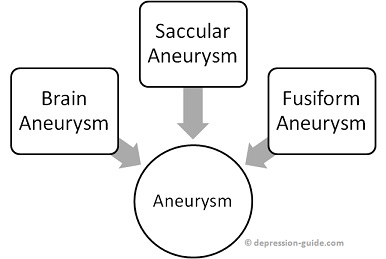Aneurysm Disorder of Brain
TweetAneurysm is an illness of blood vessels. Very abnormal and weak spot occues on the blood vessel which can cause the bulging or swelling at the spot in the vessel or arterial wall. They are of multiple types causing the blood vessel to form a sac or swell or separate the walls. Based on this, there are many types of aneurysm (Fusiform, Saccular or Dissecting). Although Aneurysm can effect any part of the body, the severe form of the illness occurs when it occurs in head and can cause serious medical condition such as stroke, brain damage and death.
Statistics on Aneurysm
About one in 14 people in the US are affected by this illness during their lifetime. Since in many of the cases, there are no symptoms, the disease passes on without detection. There are multiple figures in researchers community about the number of aneurysms - ranging from 1 in 15 to 1 in 100. From the severity point of view, only one in about 12000 people had the ruptured brain Aneurysm. This illness is more common in pople who are above 40 and affects women more than men.

Types of Aneurysm
- Brain aneurysm - This is the case when the arteries in the brain, specially branching points swells up and blood fills in them. Brain aneurysms potentially can rupture and cause bleeding which is known as subarachnoid hemorrhage.
- A saccular aneurysm - is the most common type of aneurysm and causes nontraumatic subarachnoid hemorrhage (SAH). It is also known as berry aneurysm.
- The fusiform aneurysm - Very less in number, it looks like an artery is expanded from both sides or in all directions. This seldom ruptures.
How to handle Brain Aneurysm?
Brain Aneurysm is detected only when the rupture happens and it shows the signs of brain damage or other hemorrhage symptoms like stroke, etc. Sometimes, the size of unruptured brain Aneurysm is enough to press against the other parts of brain causing headache, vision issues, speech changes, etc.
Most of the times, the symtpoms of ruptured brain Aneurysm happens very suddenly and you should call call for medical help immediately. Here are some of the symptoms to look for:
- Severe headache very different from earlier headaches.
- Pain in Neck
- Nausea and vomiting
- Sudden light sensitivity
- Stroke or fainting
- Seizures
Treatment of Brain Aneurysm
There are options such as surgical clipping or endovascular management available for ruptured Brain Aneurysm. If it is detected and not ruptured yest, then there are options like keeping it under observation or treating it.


Sometimes crying or laughing
are the only options left,
and laughing feels better right now.

Current Issue
 Self Help Leaflets Take the help of our self help leaflets or booklets. |
 The DG Magazine All about living with depression |
Brain Disorders
Brain Disorders
- Transverse myelitis
- Chiari malformation
- Amyotrophic lateral sclerosis
- Coma
- Concussion
- Encephalitis
- Delirium
- Essential Tremor
- Post Concussion Syndrome
- Brain Tumor
- Intracranial Hematoma
- Transient global amnesia
- Reye's syndrome
- Autonomic neuropathy
- Bell's palsy
- Acoustic neuroma
- Benign paroxysmal positional vertigo (BPPV)
- Brachial plexus injury
- Cerebral palsy
- Charcot Marie Tooth disease
- Complex regional pain syndrome
- Dystonia
- Foot drop
- Guillain-Barre syndrome
- Krabbe disease
- Meniere's disease
- Myasthenia gravis
- Optic neuritis
- Peripheral neuropathy
- Phantom pain
- Post-polio syndrome
- Postherpetic neuralgia
- Progressive supranuclear palsy
- Ramsay Hunt syndrome
- Spasmodic torticollis
- Spinal cord injury
- Spinal stenosis
- Trigeminal neuralgia
- Vocal cord paralysis
- Whiplash
- Primary progressive aphasia
- Leukodystrophies
- Wilson's Disease
- Aneurysm
- Aphasia












